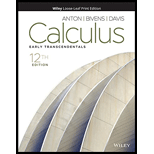
Concept explainers
Classify the following first-order differential equations as separable, linear, both, or neither.
(a)
The given differential equation,
Answer to Problem 1RE
The given equation is linear.
Explanation of Solution
For an equation to be separable, it should be of the form,
Since the equation,
For an equation to be linear, it should be of the form,
Since the equation,
Hence, the given equation is linear.
(b)
The given differential equation,
Answer to Problem 1RE
The given equation is both linear and separable.
Explanation of Solution
For an equation to be separable, it should be of the form,
Consider the given equation.
So, the given equation follows
For an equation to be linear, it should be of the form,
Since the equation,
Hence, the given equation is both linear and separable.
(c)
The given differential equation,
Answer to Problem 1RE
The given equation is separable.
Explanation of Solution
For an equation to be separable, it should be of the form,
Consider the given equation.
So, the given equation is of the form,
It can’t be linear as it cannot be written in the form of
Hence, the given equation is separable.
(d)
The given differential equation,
Answer to Problem 1RE
The given equation is neither separable nor linear.
Explanation of Solution
For an equation to be separable, it should be of the form,
Consider the given equation.
Since the equation,
It can’t be linear as it not of the form,
Hence, the given equation is neither separable nor linear.
Want to see more full solutions like this?
Chapter 8 Solutions
Calculus: Early Transcendentals, Enhanced Etext
Additional Math Textbook Solutions
Calculus: Early Transcendentals (2nd Edition)
Basic Business Statistics, Student Value Edition
Thinking Mathematically (6th Edition)
University Calculus: Early Transcendentals (4th Edition)
Elementary Statistics (13th Edition)
- #14 Sand pours from a chute and forms a conical pile whose height is always equal to its base diameter. The height o the pile increases at a rate of 5 feet/hour. Find the rate of change of the volume of the sand in the conical pile when the height of the pile is 4 feet.arrow_forward(d)(65in(x)-5 cos(x) dx mins by 5x-2x² 3x+1 dx -dx 20 Evaluate each the following indefinite integralsarrow_forward19 Evaluate each the following definite integrals: a) લ b) (+3) 6) (2-2)(+33) dxarrow_forward
- #11 If a snowball melts so its surface area decreases at a rate of 1cm²/min, find the rate at which the diameter decreases when the diameter is 6 cm.arrow_forwardUse Deritivitve of the inverse to solve thisarrow_forwardEvaluate the following Limits: e6x-1 Lim +0Sin3x 7x-5x2 2x-1+ Cos 4x +6 c) Lim b) Lim + x³-x2 X-0 1-e' 4x d) Lim 6x²-3 X+0 6x+2x² Find the derivatives of the following functions using the Limit definition of derivativearrow_forward
- 15A cylindrical tank with radius 8 m is being filled with water at a rate of 2 m³/min. What is the rate of change of the water height in this tank? 6)A box with a square base and an open top must box that will minimiarrow_forward#12 The radius of a sphere increases at a rate of 3 in/sec. How fast is the volume increasing when the diameter is 24arrow_forward84 256 cubic inches. Find the dimensions of the of material used (the surface area). A farmer wishes to enclose a rectangular plot using 200 m of fencing material. One side of the land borders a river and does not need fencing. What is the largest area that can be enclosed? For the function y=x³-3x²-1, use derivatives to: 3 b) 2x - 6x2 (a) determine the intarrow_forward
- Can you solve this 6 questions numerical method and teach me how to solve it and what we use.arrow_forward9Wire of length 20m is divided into two pieces and the pieces are bent into a square and a circle. How should this be done in order to minimize the sum of their areas? Round your answer to the nearest hundredth.arrow_forwardUse Laplace transform to solve the initial value problem y' + y = tsin(t), y(0) = 0arrow_forward
 Linear Algebra: A Modern IntroductionAlgebraISBN:9781285463247Author:David PoolePublisher:Cengage Learning
Linear Algebra: A Modern IntroductionAlgebraISBN:9781285463247Author:David PoolePublisher:Cengage Learning
